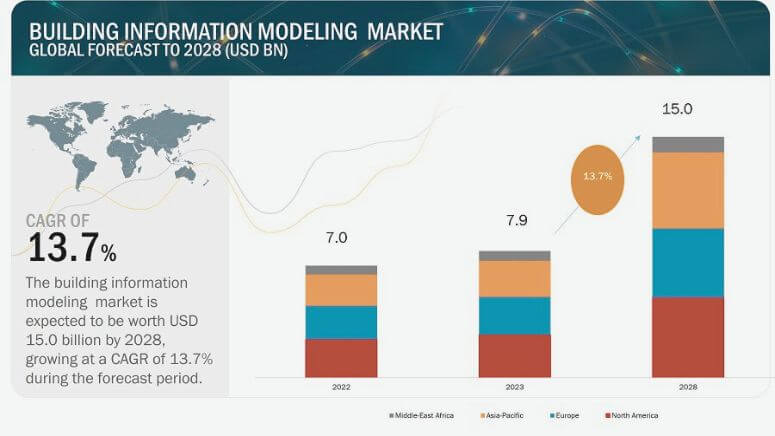The world of technology takes every walk with time. It affects almost every segment of homes, businesses, and industries all around the globe – even including the Architectural, Engineering, and Construction (AEC) sector.
This business is now very much into the latest advanced technologies like drones for construction, digital twin, modular construction, additive manufacturing, smart cities, and so on, but above all, attributed to the BIM (Building Information Modeling). By comparing these innovations, BIM modeling stands out as the primary and unique trend because of its importance and its unprecedented need.
Due to the fast-paced market stimulated by the development and advancement in technology and the rapid urbanization, firms from different countries are trying to adopt BIM Services to stay on the edge.
BIM deployment is increasingly being used as it shows the necessity of its usage now. Through BIM technology, countries can pick up a strong foundation for their projects’ infrastructural initiatives, rising above other countries with the best construction accomplishments.
We see the world’s face change every second because of technological achievements. With the widening of the urbanization rate along with the appearance of smart cities, the world’s leading countries, in turn, are becoming concentrated on BIM applications.
BIM is the way to get a more structured base for infrastructural development that can present such quality to the world. Like any other sector, when we are gradually advancing in 2024, it is imperative to explain the global BIM adoption area.
We need to deeply analyze their application strategies and the current trends within these major nations worldwide. We go into a profound, in-depth analysis of the application of strategies and the ongoing trends within the major countries.
BIM Adoption Statistics
The worldwide adoption of Building Information Modeling (BIM) is gaining momentum, and it is being noticed as the best way of facilitating collaboration, enhancing project efficiency, and decreasing costs.
As per the new records, BIM application has become the leading practice in developed and developing countries, and BIM utilization is expanding with more and more projects applying BIM technologies every year.

According to the latest report on the global Building Information Modeling (BIM) market static, it was valued at $7.9 billion in 2023, with projections that it will reach $15.0 billion by 2028 at a Compound Annual Growth Rate (CAGR) of 13.7% during the forecast period.
It’s time to uncover 13 countries that are at the forefront of this latest innovative technological wave.
Leading Countries in Global BIM Adoption
Exploring the top countries adopting Building Information Modeling (BIM) unveils a global trend towards innovation and significantly improved efficiencies in the construction sector.
This widespread adoption showcases how technology is reshaping the way buildings are designed, constructed, and maintained, offering insights into the future of architectural and engineering practices worldwide.
United Kingdom
With the Government’s support, the UK stands out by its pioneering strategic plan for Building Information Modelling (BIM) with its talented designers and contractors who, in turn, have improved the national influence of their building sector professionals.
UK directed in April 2016 to the use of BIM Level 2 for all public projects, a step that set the UK to be the world’s most digitized and technologically advanced construction industry. As a result of this government push, analyses suggest a discreet implementation of 20% within the industry and a strong growth of 12% since 2017. can be observed.
United States
BIM (Building Information Modelling) is distinguished as the first global phenomenon in the construction industry. United States researchers pioneered the development of the field during the 1990s and since the 1970s in accordance with its application.
However, BIM is designed not to be a must in all US states, but the rate at which its acceptance is growing is worth mentioning. Wisconsin has moved to the frontline in using BIM public management of projects with budgets at this and the above figure. Even though BIM implementation favored a slower rate three years ago, a significant upsurge has been witnessed in recent years.
The US construction sector has been evolving slowly post-digital to embrace its highly experimental characteristics. Ongoing endeavors are being pursued to ensure the development and implementation of long-term solutions and renewal are continuing.
France
France is a frontrunner in the e-construction vertical, as BIM industry-specific standards have been developed for infrastructure projects.
French pacesetting took place in 2014 and is all BIM-based. Besides, the EU has invested around €20 million in implementing air sensor networks and digitization of the construction industry. Bringing aside, by the end of 2016, BIM will be made mandatory for government projects, leaving no doubt that public authorities are on a fast lane to digital transformation.
It is the Digital Transition Plan that the concept is part of and aims to stir up sustainability and bring saving to the table. It is thought that the broad implementation of BIM can stimulate the economy by improving the environment, improving society, and creating additional demand for small and medium-sized enterprises.
Finland
Finland has taken the lead in BIM technology since 2002 and has made Shanghai Castle’s BIM compliance and model with IFC a sine qua non for all projects since 2007 when Senate Properties, a government body dealing with the management of national assets, took this step.
In 2001, the Government of Finland announced that BIM would be introduced as a mandatory process in state-funded projects starting at that moment. This move positioned Finland at the top of BIM implementation, with 93% of architectural firms and 60% of engineering firms adopting BIM practices by 2007.
Sweden
The Swedish Government made BIM implementation obligatory in 2015, resulting in BIM adoption in over 75% of all central procurement processes.
A prerequisite to this mandate was that Sweden had already been a country very active in promoting BIM since 1991 through various guides and examples of best practices. In 2014, representatives from both the private and public sectors joined BIM Alliance Sweden’s ranks to improve construction standards.
Denmark
Since 2000, Denmark has noticed significant BIM ripoffs. Up to 50% of all construction professionals will have adapted BIM systems by 2006. Universities have borne further commitment to BIM, and government legislation in 2007 required BIM software for projects, including those by Defense Construction Services and the Palace and Properties Agency.
Even though a critical player in this effort, the private sector places the primary emphasis on the R&D of BIM to improve its rates and adaptability.
Norway
Statistics Norway and Norwegian homebuilding organizations that have to do with construction in public and governance promulgated and implemented the usage of BIM in 2009.
In contrast, since 2010, models have had to comply with IFC standards. SINTEF backs up the work of the research institutions that work with sustainable models and BIM solutions to avoid construction inefficiency.
Singapore
Since 2015, the BIM mandate by the Singapore Construction Authority has been applied to all public projects, funded by a S$250 million budget set aside for the BIM project. Digitalization initiatives like introducing the BIM e-submission system drew the line at larger projects (> 5,000 sq.m), contributing to considerable efficiency gains.
United Arab Emirates
With the economy advancing at a rapid pace in the UAE, BIM (Building Information Modelling) has come to be progressively integrated into the construction sector as of 2014, which now mandates the model on large projects. Although the process is both gradual and organic, some larger projects have used BIM to advance the sector.
China
As of the year 2016, Chinese AEC practitioners have been experiencing a similar rise in BIM adoption initiatives with the primary aim of providing high growth rates simultaneously with digitalization.
On the contrary, BIM usage is not mandatory, but it is strongly suggested as a way of adapting the vast construction industry of China to the modern era.
Australia
As the economic impact is 7.8% of the national GDP, the construction sector in Australia is becoming almost famous for using BIM to make its operations conventional. Oppositely, despite different strategies and the absence of a unified approach, the adoption of BIM by several private entities has occurred already.
In 2016, the Government requested an intelligent infrastructure task force to follow all government projects above $50 million by BIM, which is estimated to have a market value of approximately $6.5 billion by 2020.
Russia
The Russian government has made significant strides in its digital transformation, employing BIM for the construction of the 2014 Sochi Winter Olympics venues.
In 2016, a federal law mandated BIM usage for state-funded projects over $50 million. With the country’s focus on urbanization and infrastructure development, BIM adoption is expected to grow significantly.
However, in 2022 it will be BIM Technology that will have the largest increase in growth at 14.4%. 2024 Nationwide Standard Report Statistics on Intelligence Modeling Technologies for Residential Houses Approved.
The fact is that BIM is operating in Moscow, St.Petersburg, Kazan, Ufa, and Yekaterinburg for real estate developers and construction companies now at a moment. For Russia, putting good laws and regulations in place and also providing a good support base for BIM implementation to be carried out may be the only motivating factor that will attract a fast BIM adaptation in the Russian construction industry.
Germany
The German construction industry underwent quite a revolution, but that process was not free of internal contradictions and miscommunication among the authorities.
Confronting falling financial gains and the rapid decrease in project numbers throughout the last decade, Germany has embarked on BIM adoption, and the mandatory use of this model is likely by 2020.
The spotlight is increasingly on the collaborative approach brought about via technology in all construction stages. A BIM pilot started in 2016, and it digitalized transportation projects.
Conclusion
BIM adoption by countries, as documented, is at an upward trend globally, as more countries are adopting this technology in their construction sectors. Public and private sectors can see what BIM can do to improve processes and maximize gains that significantly affect their sustainability initiatives, prompting the implementation of BIM for their projects.
The emergence of such technologies will no doubt shape the industry in the coming years as construction becomes more advanced elsewhere in the world. BIM is future oriented and everybody in the industry must update their know-how about technologies and be responsive to the new solutions to remain in the market.
Chudasama Outsourcing, a leading BIM outsourcing company, offers top-notch BIM services to enhance construction process efficiency. Our scalable, cost-effective solutions adhere to global construction standards, optimizing your project’s success.




